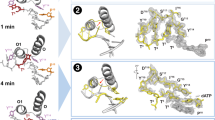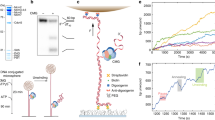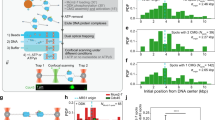Abstract
Gyrase is an essential bacterial molecular motor that supercoils DNA using a conformational cycle in which chiral wrapping of > 100 base pairs confers directionality on topoisomerization. To understand the mechanism of this nucleoprotein machine, global structural transitions must be mapped onto the nucleotide cycle of ATP binding, hydrolysis and product release. Here we investigate coupling mechanisms using single-molecule tracking of DNA rotation and contraction during Escherichia coli gyrase activity under varying nucleotide conditions. We find that ADP must be exchanged for ATP to drive the rate-limiting remodeling transition that generates the chiral wrap. ATP hydrolysis accelerates subsequent duplex strand passage and is required for resetting the enzyme and recapturing transiently released DNA. Our measurements suggest how gyrase coordinates DNA rearrangements with the dynamics of its ATP-driven protein gate, how the motor minimizes futile cycles of ATP hydrolysis and how gyrase may respond to changing cellular energy levels to link gene expression with metabolism.
This is a preview of subscription content, access via your institution
Access options
Access Nature and 54 other Nature Portfolio journals
Get Nature+, our best-value online-access subscription
$29.99 / 30 days
cancel any time
Subscribe to this journal
Receive 12 print issues and online access
$259.00 per year
only $21.58 per issue
Buy this article
- Purchase on Springer Link
- Instant access to full article PDF
Prices may be subject to local taxes which are calculated during checkout





Similar content being viewed by others
References
Dutta, R. & Inouye, M. GHKL, an emergent ATPase/kinase superfamily. Trends Biochem. Sci. 25, 24–28 (2000).
Saraste, M., Sibbald, P. R. & Wittinghofer, A. The P-loop—a common motif in ATP- and GTP-binding proteins. Trends Biochem. Sci. 15, 430–434 (1990).
Schoeffler, A. J. & Berger, J. M. DNA topoisomerases: harnessing and constraining energy to govern chromosome topology. Q. Rev. Biophys. 41, 41–101 (2008).
Basu, A., Parente, A. C. & Bryant, Z. Structural dynamics and mechanochemical coupling in DNA gyrase. J. Mol. Biol. 428, 1833–1845 (2016).
Wang, J. C. Cellular roles of DNA topoisomerases: a molecular perspective. Nat. Rev. Mol. Cell Biol. 3, 430–440 (2002).
Peter, B. J. et al. Genomic transcriptional response to loss of chromosomal supercoiling in Escherichia coli. Genome Biol. 5, R87 (2004).
Chong, S., Chen, C., Ge, H. & Xie, X. S. Mechanism of transcriptional bursting in bacteria. Cell 158, 314–326 (2014).
Pommier, Y., Leo, E., Zhang, H. & Marchand, C. DNA topoisomerases and their poisoning by anticancer and antibacterial drugs. Chem. Biol. 17, 421–433 (2010).
Bustamante, C., Chemla, Y. R., Forde, N. R. & Izhaky, D. Mechanical processes in biochemistry. Annu. Rev. Biochem. 73, 705–748 (2004).
Cheung, K. J., Badarinarayana, V., Selinger, D. W., Janse, D. & Church, G. M. A microarray-based antibiotic screen identifies a regulatory role for supercoiling in the osmotic stress response of Escherichia coli. Genome Res. 13, 206–215 (2003).
van Workum, M. et al. DNA supercoiling depends on the phosphorylation potential in Escherichia coli. Mol. Microbiol. 20, 351–360 (1996).
Brown, P. O. & Cozzarelli, N. R. A sign inversion mechanism for enzymatic supercoiling of DNA. Science 206, 1081–1083 (1979).
Papillon, J. et al. Structural insight into negative DNA supercoiling by DNA gyrase, a bacterial type 2A DNA topoisomerase. Nucleic Acids Res. 41, 7815–7827 (2013).
Gubaev, A. & Klostermeier, D. The mechanism of negative DNA supercoiling: a cascade of DNA-induced conformational changes prepares gyrase for strand passage. DNA Repair (Amst. 16, 23–34 (2014).
Bryant, Z., Oberstrass, F. C. & Basu, A. Recent developments in single-molecule DNA mechanics. Curr. Opin. Struct. Biol. 22, 304–312 (2012).
Basu, A., Schoeffler, A. J., Berger, J. M. & Bryant, Z. ATP binding controls distinct structural transitions of Escherichia coli DNA gyrase in complex with DNA. Nat. Struct. Mol. Biol. 19, 538–546 (2012).
Lebel, P., Basu, A., Oberstrass, F. C., Tretter, E. M. & Bryant, Z. Gold rotor bead tracking for high-speed measurements of DNA twist, torque and extension. Nat. Methods 11, 456–462 (2014).
Gore, J. et al. Mechanochemical analysis of DNA gyrase using rotor bead tracking. Nature 439, 100–104 (2006).
Baird, C. L., Harkins, T. T., Morris, S. K. & Lindsley, J. E. Topoisomerase II drives DNA transport by hydrolyzing one ATP. Proc. Natl. Acad. Sci. USA 96, 13685–13690 (1999).
Schwenkert, S., Hugel, T. & Cox, M. B. The Hsp90 ensemble: coordinated Hsp90-cochaperone complexes regulate diverse cellular processes. Nat. Struct. Mol. Biol. 21, 1017–1021 (2014).
Dong, K. C. & Berger, J. M. Structural basis for gate-DNA recognition and bending by type IIA topoisomerases. Nature 450, 1201–1205 (2007).
Bax, B. D. et al. Type IIA topoisomerase inhibition by a new class of antibacterial agents. Nature 466, 935–940 (2010).
Kulić, I. M., Mohrbach, H., Lobaskin, V., Thaokar, R. & Schiessel, H. Apparent persistence length renormalization of bent DNA. Phys. Rev. E 72, 041905 (2005).
Vologodskii, A. Determining protein-induced DNA bending in force-extension experiments: theoretical analysis. Biophys. J. 96, 3591–3599 (2009).
Hardin, A. H. et al. Direct measurement of DNA bending by type IIA topoisomerases: implications for non-equilibrium topology simplification. Nucleic Acids Res. 39, 5729–5743 (2011).
Sugino, A. & Cozzarelli, N. R. The intrinsic ATPase of DNA gyrase. J. Biol. Chem. 255, 6299–6306 (1980).
Gubaev, A. & Klostermeier, D. DNA-induced narrowing of the gyrase N-gate coordinates T-segment capture and strand passage. Proc. Natl. Acad. Sci. USA 108, 14085–14090 (2011).
Lindsley, J. E. & Wang, J. C. On the coupling between ATP usage and DNA transport by yeast DNA topoisomerase II. J. Biol. Chem. 268, 8096–8104 (1993).
Yasuda, R., Noji, H., Kinosita, K. Jr. & Yoshida, M. F1-ATPase is a highly efficient molecular motor that rotates with discrete 120 degree steps. Cell 93, 1117–1124 (1998).
Wang, H. & Oster, G. Energy transduction in the F1 motor of ATP synthase. Nature 396, 279–282 (1998).
Schmidt, B. H., Osheroff, N. & Berger, J. M. Structure of a topoisomerase II-DNA-nucleotide complex reveals a new control mechanism for ATPase activity. Nat. Struct. Mol. Biol. 19, 1147–1154 (2012).
Tretter, E. M. & Berger, J. M. Mechanisms for defining supercoiling set point of DNA gyrase orthologs: I. A nonconserved acidic C-terminal tail modulates Escherichia coli gyrase activity. J. Biol. Chem. 287, 18636–18644 (2012).
Fernández-Sierra, M., Shao, Q., Fountain, C., Finzi, L. & Dunlap, D. E. coli gyrase fails to negatively supercoil diaminopurine-substituted DNA. J. Mol. Biol. 427, 2305–2318 (2015).
Nöllmann, M. et al. Multiple modes of Escherichia coli DNA gyrase activity revealed by force and torque. Nat. Struct. Mol. Biol. 14, 264–271 (2007).
Dorman, C. J. Regulation of transcription by DNA supercoiling in Mycoplasma genitalium: global control in the smallest known self-replicating genome. Mol. Microbiol. 81, 302–304 (2011).
Dorman, C. J. Genome architecture and global gene regulation in bacteria: making progress towards a unified model? Nat. Rev. Microbiol. 11, 349–355 (2013).
Hsieh, L. S., Burger, R. M. & Drlica, K. Bacterial DNA supercoiling and [ATP]/[ADP]. Changes associated with a transition to anaerobic growth. J. Mol. Biol. 219, 443–450 (1991).
Westerhoff, H. V., O’Dea, M. H., Maxwell, A. & Gellert, M. DNA supercoiling by DNA gyrase. A static head analysis. Cell Biophys. 12, 157–181 (1988).
Bennett, B. D. et al. Absolute metabolite concentrations and implied enzyme active site occupancy in Escherichia coli. Nat. Chem. Biol. 5, 593–599 (2009).
Hsieh, L. S., Rouviere-Yaniv, J. & Drlica, K. Bacterial DNA supercoiling and [ATP]/[ADP] ratio: changes associated with salt shock. J. Bacteriol. 173, 3914–3917 (1991).
Adachi, K. et al. Coupling of rotation and catalysis in F1-ATPase revealed by single-molecule imaging and manipulation. Cell 130, 309–321 (2007).
Chistol, G. et al. High degree of coordination and division of labor among subunits in a homomeric ring ATPase. Cell 151, 1017–1028 (2012).
Gubaev, A., Weidlich, D. & Klostermeier, D. DNA gyrase with a single catalytic tyrosine can catalyze DNA supercoiling by a nicking-closing mechanism. Nucleic Acids Res. 44, 10354–10366 (2016).
Thomsen, N. D. & Berger, J. M. Structural frameworks for considering microbial protein- and nucleic acid-dependent motor ATPases. Mol. Microbiol. 69, 1071–1090 (2008).
Pato, M. L., Howe, M. M. & Higgins, N. P. A. DNA gyrase-binding site at the center of the bacteriophage Mu genome is required for efficient replicative transposition. Proc. Natl. Acad. Sci. USA 87, 8716–8720 (1990).
Lindsley, J. E. Use of a real-time, coupled assay to measure the ATPase activity of DNA topoisomerase II. Methods Mol. Biol. 95, 57–64 (2001).
Lanzetta, P. A., Alvarez, L. J., Reinach, P. S. & Candia, O. A. An improved assay for nanomole amounts of inorganic phosphate. Anal. Biochem. 100, 95–97 (1979).
Acknowledgements
This work was supported by National Institutes of Health R01 grants GM106159 to Z.B. and CA077373 to J.M.B., a Stanford Bio-X Graduate Fellowship to A.B. and a Stanford Interdisciplinary Graduate Fellowship to P.M.L. NIH training grant 5T32GM008403-24 supported M.H.
Author information
Authors and Affiliations
Contributions
A.B. designed and performed single-molecule experiments, analyzed single-molecule data and carried out theoretical modeling. M.H. designed and performed bulk biochemical experiments. A.B., P.L. and L.E.F. developed and characterized single-molecule tools and methods. M.H. and E.M.T. provided purified proteins. A.B., Z.B. and M.H. wrote the paper. All authors commented on the paper and discussed the results. Z.B. and J.M.B. supervised research.
Corresponding author
Ethics declarations
Competing interests
The authors declare no competing financial interests.
Additional information
Publisher’s note: Springer Nature remains neutral with regard to jurisdictional claims in published maps and institutional affiliations.
Supplementary information
Supplementary Text and Figures
Supplementary Tables 1–4 and Supplementary Figures 1–9
Rights and permissions
About this article
Cite this article
Basu, A., Hobson, M., Lebel, P. et al. Dynamic coupling between conformations and nucleotide states in DNA gyrase. Nat Chem Biol 14, 565–574 (2018). https://doi.org/10.1038/s41589-018-0037-0
Received:
Accepted:
Published:
Issue Date:
DOI: https://doi.org/10.1038/s41589-018-0037-0
This article is cited by
-
Cochaperones convey the energy of ATP hydrolysis for directional action of Hsp90
Nature Communications (2024)
-
Extracting time series matching a small-angle X-ray scattering profile from trajectories of molecular dynamics simulations
Scientific Reports (2022)
-
Deciphering the mechanical code of the genome and epigenome
Nature Structural & Molecular Biology (2022)
-
Cryo-EM structure of the complete E. coli DNA gyrase nucleoprotein complex
Nature Communications (2019)



